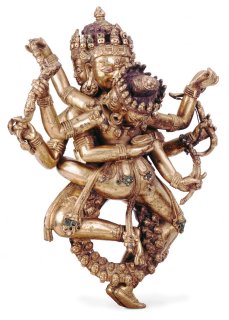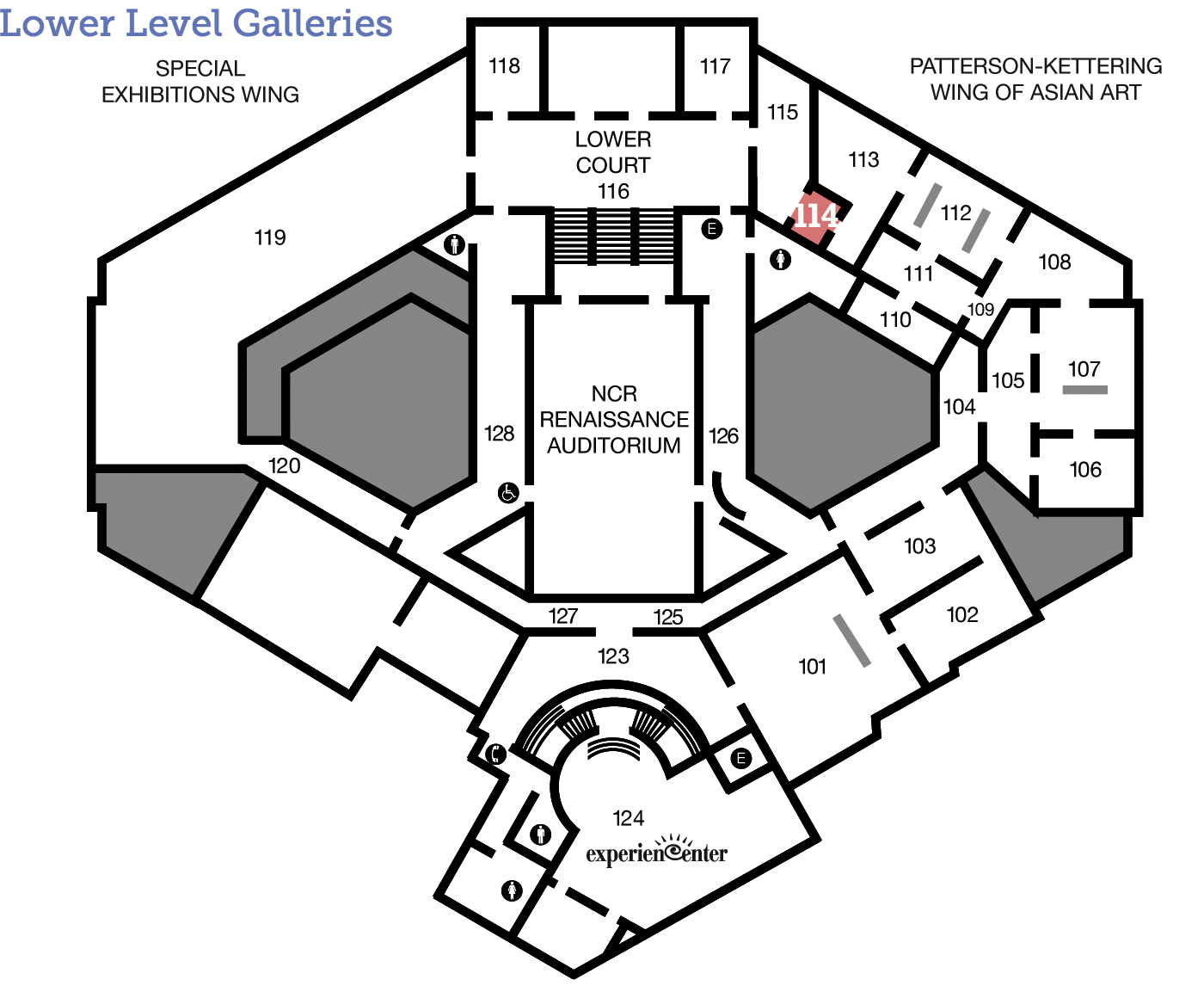
Tibeto-Chinese
Mahamaya and Buddhadakini
Bronze with gilt and semi-precious stones 12 x 9 x 6 ½ inches Museum purchase with funds provided by Mrs. Virginia W. Kettering 1980.12
Shock and Awe
In a flash of golden light, figures take shape; a cyclone of heads, arms, and legs. What do you see? Welcome to the world of Tibetan Buddhist art.
A Day in the Life
Art as a Way to See the Buddha
What role does art play in the daily life of monks and ordinary people in Tibet? How does it enhance their experience of Buddhism? Find out more in the following video from the Asian Art Museum.
Copyright © Asian Art Museum Chong-Moon Lee Center for Asian Art and Culture, 2002
Transcript:
Narrator: The Buddhism of Tibet has been influential throughout the Himalayan region. What function does art play in Tibetan Buddhism?
Donald S. Lopez, Jr.: The Tibetans don’t really have a word for art. The term is gundha, “something which is like the body.” And the term “body” is an honorific term, so it’s “like the body of the Buddha.” A painting or a statue is not considered complete unless it’s been consecrated. In a ritual, the spirit of that deity is made to enter into—physically enter into—and inhabit that painting or that statue. Not as if it were the deity; it is the deity in a very important sense.
Narrator: Many artworks can be used as tools for meditation.
Lama Arjia Rinpoche: The mandala is the Buddha field; it’s where the Buddha lives. So, when you do the practice, then you have to have the model of the Buddha fields. So the mandala actually has two meanings: one is the model for your visualization, the other meaning is the ritual.
Narrator: Ritual objects play an important part in Tibetan ceremonies. In practice, the thunderbolt and bell are manipulated by monks in prescribed movements. Monasteries are the center of Buddhist life where monks spend much of the day debating Buddhist philosophy.
Lama Arjia Rinpoche: Tibetan Buddhism seems to me more like philosophy. So debating is the practice for analyzing and understanding the philosophy part.
Narrator: Ordinary Tibetans worship using prayer wheels and prayer beads. They make pilgrimages to sacred places. At festivals, the monks bring out special objects and perform sacred music and dance. Tibetan Buddhism has become increasingly popular worldwide. Its practices are becoming better understood, and scholars of medicine, religion, philosophy and psychology have begun to look to it for inspiration and insight.
Tools and Techniques
From Wax to Wonder
This bronze sculpture was made with the lost-wax process, a technique for making metal sculptures that has been used in many regions around the world. It allows an artisan to achieve the greatest detail in each sculpture. However, because the mold is destroyed when it is cooled, each exquisite piece is one-of-a-kind. How does it work? See one example in the following video from the Victoria and Albert Museum. (Note: there is no sound with this video.)
Lost Wax Bronze Casting from Victoria and Albert Museum on Vimeo.
Behind the Scenes
Hidden Meaning?
This sculpture, like much Tibetan art, is made to be used in ritual practice, such as meditation. But before an object can be used it must be consecrated. During a ceremony the image is filled with the presence of the figure it represents, activating the object, so to speak. For bronze sculptures this may involve filling the inside with a variety of sacred objects, such as small scrolls with sacred texts written on them, mandalas (spiritual diagrams), relics of a lama (priest), clay figures, pieces of silk, grains, or aromatic powder. For an example of this, see the video in “A Day in the Life”.
Statues were filled from the base or the back. If you look at the back of this statue, you can see a small square incised. This may indicate the object was filled and sealed at this point, although studies of other statues have shown that such markings may only be superficial and contain nothing.
Further reading: Chandra L. Reedy, “The Opening of Consecrated Tibetan Bronzes with Interior Contents: Scholarly, Conservation, and Ethical Considerations,” Journal of the American Institute of Conservation 30/1 (1991): 13–34; Gennady Leonov, “The Rite of Consecration in Tibetan Buddhism,” Arts of Asia 22/5 (Sept.–Oct. 1992): 100–110.
Look Closer
Just for Kids
Signs & Symbols
An Ideal Image?
Why do these figures look so angry? And isn’t their pose a little racy? It might surprise you to learn that these features are meant to help you realize the Buddhist ideal of a union between wisdom and compassion.
This male figure is an example of a yidam, a symbolic deity that is a manifestation of the Buddha and embodies Buddhist enlightenment. The name of this one is Mahamaya. Yidam often appear in a “father-mother union” pose (yab-yum), where the male figure is joined with a female counterpart, in this case a figure named Buddhadakini. The female symbolizes wisdom, seeing through the ignorance that is the human attachment to things, especially an ego-centered self. This wisdom leads to compassion, true concern for oneself and for others, which is symbolized by the male. Each needs the other: compassion must be based on wisdom, and true wisdom will always result in compassionate action.
Why do they look so intense? Tibetan art has many ferocious images, and the point is to use the fearful appearance to conquer the fearful things that result from ignorance, such as greed or death. Here, each figure holds a kind of staff with three heads (khatvanga), a bow (sara), an arrow (capa), and a skull bowl filled with blood (kapala). Together, they symbolize the kind of fierce strength a practitioner needs to conquer ignorance.
A sculpture like this would be used in meditation, and the person using it would be taught about its symbolic meaning. Meditating with it would help one envision the Buddhahood he or she is working towards.
Further reading: Marilyn M. Rhie and Robert A. F. Thurman, Wisdom and Compassion: The Sacred Art of Tibet (New York: Harry N. Abrams, 1991).
Dig Deeper
Arts Intersected
The Sculpture Speaks
Did You Know?
Expert Opinion
Dazzling!
Take a look at this sculpture through a curator’s eyes! Listen as Dominique Vasseur, former Senior Curator at The DAI from 1979–1999, discusses what makes it special.
Look Around
About the Artist
Who made it?
Tibetan art is largely anonymous, although there are some examples with an artist’s name. Instead of emphasizing self-expression, the focus is on crafting a well-made sculpture or painting that follows accepted conventions. When a work of art is successfully completed, it has an existence of its own and an inherent power to help the viewer in her or his spiritual practice.
Talk Back
Anonymous
There is no artist’s signature on this sculpture. In many cultures, identifying the maker was not considered important. Yet, often we determine if something is a “masterpiece” by looking at the person who made it—a sketch by Michelangelo will be valued more than a sketch by an unnamed artist. To what extent does knowing who the artist is determine whether a work of art is significant? Are there other factors that may be more important?

